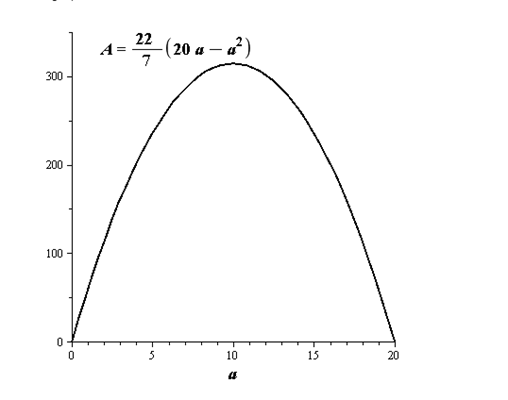
Concept explainers
(a)
Write the area of the ellipse as a function of
(a)
Answer to Problem 67E
Area=
Explanation of Solution
Given:
The general form of the ellipse as
Also,
The area of the ellipse is given as
To express the area in terms of the variable a.
From equation (1)
Substituting the value of B in the expression for area,
Area=
(b)
Find the equation of an ellipse with an area of 264 square centimeters.
(b)
Answer to Problem 67E
The general equation,
Explanation of Solution
Given:
To find the equation of an ellipse with an area of 264 square centimeters.
Substituting this value in the expression for area,
This gives
Also,
Substituting the values of a and b in the general equation,
(c)
Complete the table using your equation from part (a). Then make a conjecture about the shape of the ellipse with maximum area.
(c)
Answer to Problem 67E
| | 8 | 9 | 10 | 11 | 12 | 13 |
| A | 301.6 | 311.0 | 314.2 | 311.0 | 301.6 | 285.9 |
Explanation of Solution
Given:
| | 8 | 9 | 10 | 11 | 12 | 13 |
| A | 301.6 | 311.0 | 314.2 | 311.0 | 301.6 | 285.9 |
The various values of a are given.
From the above table the maximum area occurs at NA=10
In this case, both a and b turn out to be 10.
Thus, a circle has maximum area.
(d)
To graph the area function using a graphing utility.
(d)
Answer to Problem 67E
Graph is shown below.
The peak of the curve occurs at
Explanation of Solution
Given:
The area function is given as
The area function is given as
The graph comes out to be

The peak of the curve occurs at
Chapter 10 Solutions
EBK PRECALCULUS W/LIMITS
- For the system consisting of the lines: and 71 = (-8,5,6) + t(4, −5,3) 72 = (0, −24,9) + u(−1, 6, −3) a) State whether the two lines are parallel or not and justify your answer. b) Find the point of intersection, if possible, and classify the system based on the number of points of intersection and how the lines are related. Show a complete solution process.arrow_forward3. [-/2 Points] DETAILS MY NOTES SESSCALCET2 7.4.013. Find the exact length of the curve. y = In(sec x), 0 ≤ x ≤ π/4arrow_forwardH.w WI M Wz A Sindax Sind dy max Утах at 0.75m from A w=6KN/M L=2 W2=9 KN/m P= 10 KN B Make the solution handwritten and not artificial intelligence because I will give a bad rating if you solve it with artificial intelligencearrow_forward
- Solve by DrWz WI P L B dy Sind Ⓡ de max ⑦Ymax dx Solve by Dr ③Yat 0.75m from A w=6KN/M L=2 W2=9 kN/m P= 10 KN Solve By Drarrow_forwardHow to find the radius of convergence for the series in the image below? I'm stuck on how to isolate the x in the interval of convergence.arrow_forwardDetermine the exact signed area between the curve g(x): x-axis on the interval [0,1]. = tan2/5 secx dx andarrow_forward
 Calculus: Early TranscendentalsCalculusISBN:9781285741550Author:James StewartPublisher:Cengage Learning
Calculus: Early TranscendentalsCalculusISBN:9781285741550Author:James StewartPublisher:Cengage Learning Thomas' Calculus (14th Edition)CalculusISBN:9780134438986Author:Joel R. Hass, Christopher E. Heil, Maurice D. WeirPublisher:PEARSON
Thomas' Calculus (14th Edition)CalculusISBN:9780134438986Author:Joel R. Hass, Christopher E. Heil, Maurice D. WeirPublisher:PEARSON Calculus: Early Transcendentals (3rd Edition)CalculusISBN:9780134763644Author:William L. Briggs, Lyle Cochran, Bernard Gillett, Eric SchulzPublisher:PEARSON
Calculus: Early Transcendentals (3rd Edition)CalculusISBN:9780134763644Author:William L. Briggs, Lyle Cochran, Bernard Gillett, Eric SchulzPublisher:PEARSON Calculus: Early TranscendentalsCalculusISBN:9781319050740Author:Jon Rogawski, Colin Adams, Robert FranzosaPublisher:W. H. Freeman
Calculus: Early TranscendentalsCalculusISBN:9781319050740Author:Jon Rogawski, Colin Adams, Robert FranzosaPublisher:W. H. Freeman
 Calculus: Early Transcendental FunctionsCalculusISBN:9781337552516Author:Ron Larson, Bruce H. EdwardsPublisher:Cengage Learning
Calculus: Early Transcendental FunctionsCalculusISBN:9781337552516Author:Ron Larson, Bruce H. EdwardsPublisher:Cengage Learning





